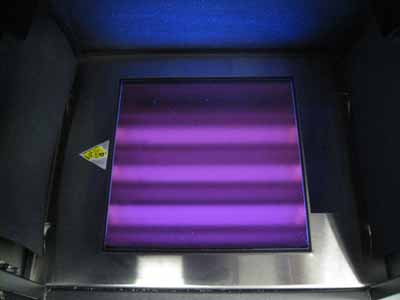 |
 |
Have we entered the era of the 1 year sequencer release cycle? *Updated*
Tuesday, January 13, 2015
Illumina's $1000 Genome*
Wednesday, January 15, 2014
A coming of age for PacBio and long read sequencing? #AGBT13
Saturday, February 23, 2013
Next Generation Sequencing rapidly moves from the bench to the bedside #AGBT13
Friday, February 22, 2013
#AGBT day one talks and observations: WES/WGS, kissing snails, Poo bacteria sequencing
Wednesday, February 20, 2013
Got fetal DNA on the brain?
Friday, September 28, 2012
Memes about 'junk DNA' miss the mark on paradigm shifting science
Friday, September 7, 2012
So, you've dropped a cryovial or lost a sample box in your liquid nitrogen container...now what?
Thursday, August 16, 2012
A peril of "Open" science: Premature reporting on the death of #ArsenicLife
Thursday, February 2, 2012
Antineoplastons? You gotta be kidding me!
Thursday, October 27, 2011
YouTube: Just a (PhD) Dream
Thursday, October 27, 2011
Slides - From the Bench to the Blogosphere: Why every lab should be writing a science blog
Wednesday, October 19, 2011
Fact Checking AARP: Why soundbytes about shrimp on treadmills and pickle technology are misleading
Monday, October 17, 2011
MHV68: Mouse herpes, not mouth herpes, but just as important
Monday, October 17, 2011
@DonorsChoose update: Pictures of the materials we bought being used!!
Friday, October 14, 2011
Is this supposed to be a feature, @NPGnews ?
Tuesday, October 4, 2011
A dose of batshit crazy: Bachmann would drill in the everglades if elected president
Monday, August 29, 2011
A true day in lab
Wednesday, August 10, 2011
A day in the lab...
Monday, August 8, 2011
University of Iowa holds Science Writing Symposium
Tuesday, April 26, 2011
Sonication success??
Monday, April 18, 2011
Circle of life
Thursday, March 17, 2011
Curing a plague: Cryptocaryon irritans
Wednesday, March 9, 2011
Video: First new fish in 6 months!!
Wednesday, March 2, 2011
The first step is the most important
Thursday, December 30, 2010
Have we really found a stem cell cure for HIV?
Wednesday, December 15, 2010
This paper saved my graduate career
Tuesday, December 14, 2010
Valium or Sex: How do you like your science promotion
Tuesday, November 23, 2010
A wedding pic.
Tuesday, November 16, 2010
To rule by terror
Tuesday, November 9, 2010
Summary Feed: What I would be doing if I wasn't doing science
Wednesday, October 6, 2010
"You have more Hobbies than anyone I know"
Tuesday, October 5, 2010
Hiccupping Hubris
Wednesday, September 22, 2010
A death in the family :(
Monday, September 20, 2010
The new lab fish!
Friday, September 10, 2010
What I wish I knew...Before applying to graduate school
Tuesday, September 7, 2010
Stopping viruses by targeting human proteins
Tuesday, September 7, 2010
 |
 |
 |
 |
Brian Krueger, PhD
Columbia University Medical Center
New York NY USA
Brian Krueger is the owner, creator and coder of LabSpaces by night and Next Generation Sequencer by day. He is currently the Director of Genomic Analysis and Technical Operations for the Institute for Genomic Medicine at Columbia University Medical Center. In his blog you will find articles about technology, molecular biology, and editorial comments on the current state of science on the internet.
My posts are presented as opinion and commentary and do not represent the views of LabSpaces Productions, LLC, my employer, or my educational institution.
Please wait while my tweets load 
 |
 |
youtube sequencing genetics technology conference wedding pictures not science contest science promotion outreach internet cheerleaders rock stars lab science tips and tricks chip-seq science politics herpesviruses
 |
 |
 |
 |
How AAAS and Science magazine really feel about sexual harassment cases in science
"This is the one thing you never want to mess around with. You'll wake up in the middle of the night crying like a baby and you'll have no idea why." These were the sage words of my undergraduate advisor, it's too bad they got discarded with everything else that I learned in undergrad.
------
My scientific career has been filled with plenty of misadventures and screw ups. Most of them are really boring mistakes that didn't involve bodily harm, and only resulted in weeks of repeated work or extended nights in the lab re-preparing samples. Though, every good scientist has an epic fail story locked away in their skeleton closet. I think many of us go into science in the beginning thinking that we're unstoppable know it alls. That is until some event punches us in the gut to tell us, "Open your eyes and pay attention or else next time I'm going to aim a little lower and negatively affect your chances of reproduction."

Bands on a DNA gel
When I was in undergrad, I worked on a bunch of projects ranging from ecology field studies to molecular biology projects in plants and fish. One of the last projects I worked on was one where we were trying to determine if fish bacterial infections could be transferred from mother to egg. This project involved collecting fish lady parts, mushing them up, and then doing a test to determine what bacteria were present. This test involved using the polymerase chain reaction (PCR) in much the same way as a paternity test. The reaction was performed and the DNA was run out on a gel. Each fish produced a series of bands and each band represented a distinct species of bacteria. These bands were then cut out of the gel, purified, and sequenced to determine what bacteria were present and if they were pathogenic. It was actually a really cool study and I spent tons of time hovering over a ultraviolet light box cutting bands out of gels. I got really good at cutting out bands and I never once had a mishap!
You may be wondering how a mishap could occur while cutting bands out of a gel. Well, I should probably explain in a little more detail for the non-scientists in the audience how we actually see bands on a DNA gel. Once DNA is isolated it is injected into the wells of an agarose gel and then size separated in a process known as electrophoresis. In short, DNA has a net negative charge, so it will move toward a positive charge in an electric field. Placing the DNA in a gel made of agarose (similar to Jell-o, but made of super expensive seaweed extract ~$900 for 500grams!) allows us to use an electric field to separate the DNA bands by size. To see the bands on the gel, we stain the gel with an awesome carcinogen called ethidium bromide.

Ethidium bromide stuck in DNA (intercalating)
This chemical stains the DNA by sticking itself inbetween the DNA bases. When ethidium bromide binds to DNA and is exposed to ultraviolet light, it fluoresces and allows us to see where the bands are in a gel. However, anyone who has ever spent too much time in the sun without sun tan lotion knows about the dangers of ultraviolet light. Now imagine if the source producing that light had a calming purple color that you could stare at without having to squint. Unlike the sun, the light produced by a UV light box only produces a small amount of visible light and a whole lot of potentially skin singeing UV light. To protect ourselves from unwanted scientist sun tans, we wear long sleeve labcoats and ALWAYS wear UV blocking lab goggles when cutting bands out of DNA gels.

The cool purple glow...
Skip ahead 3 years to my graduate career. I had just joined my PhD lab and was tasked with re-creating a very important piece of DNA for our lab. Again, I was stuck in front of a UV light box cutting bands out of a gel. The problem is that this time, I only had one band to cut, not 40! "Who needs personal protective equipment when you're only cutting out ONE band. I'm a pro at this and INVINCIBLE!!!," I thought. I pulled out my trusty razor blade, turned on the light box, stared directly into that cool purple colored light, cut out my band and went on my merry way having no idea about the pain I was going to endure in less than 8 hours.
Corneal burns are no joke. They're like ninjas waiting to pounce on you at your most vulnerable moment. I remember rolling over in bed at 3 am, blinking my eyes, and feeling the sound that fingernails make when they scratch a chalk board. It felt like someone had buffed my eyes with sand paper and then dumped crushed coke bottles in them for good measure. I blinked again and my eyes started to fill with tears, I couldn't look at anything that was brightly lit without my eyes slamming shut. I was fighting with my eye lids to keep my eyes open to try to figure out what the hell had gone so horribly wrong in the last 8 hours. After getting over the shock of not being able to see, I remembered a conversation I had with my old undergraduate advisor. When he first trained me on cutting gels, he told me this unforgettable story about the time he thought he could cut some bands out of a gel without using goggles and he woke up in the middle of the night feeling excruciating pain in his eyes. An emergency room trip later and the pain was gone but he had to take the next two days off to let his eyes heal. The crappy thing is that I totally forgot about this unforgettable story until I went through my day step by step to figure out how my eyes could go from perfectly functional to totally screwed.
I sat in bed for probably an hour trying to determine if I really needed to go to the emergency room or if I could tough it out. I finally decided I should go in, just in case I did something really bad to my eyes and needed more then just a few days of rest to heal. At the time, I was living alone in an isolated apartment on the edge of town. I had a car, but there was no way in hell I was going to be able to operate an automobile in my condition. This was also within the first 4 or 5 months of being in grad school, so I didn't have any friends I felt comfortable calling at 3 am to pick me up and take me to the ER. I reluctantly called a cab knowing that the guy was probably going to have a shit eating grin on his face once he realized I couldn't see. I had no doubt he'd take the long way...
I made it to the ER and was able to see a doctor within 45 minutes. I got some resident who had no clue what she was doing. I told her I was pretty sure I burned my eyes on the UV light box at work. She tried to get the eye scope to work so she could get a better look at the burn, but she couldn't, so she had to wake up the on call doctor to show her where the power switch was... He wasn't very happy about that but they both lit up with delight when they looked at my eyes. I had been wearing contacts and I guess it was really cool seeing the border of the burn on my cornea where the contacts blocked the UV. They ended up numbing my eyes and I called the cabbie back to come pick me up. He took the long way home, and missed the turn to my apartment complex. I called him out on it. He gave me a discount.
Again, I must say that corneal burns are no joke. I was holed up in my apartment for two days feeling miserable. I called my boss in the morning to tell him what happened and he wasn't very happy. There were two pairs of goggles and a massive face shield within 10ft of the UV light box. I really had no excuse. I felt like Kumar leaving his phone in his apartment because he had already walked out of the door and didn't want to walk back 20ft to get it. That's hilarious in a stoner movie, but laziness in real life sometimes has painful consequences. Always wear personal protective equipment when using a UV light box. Your corneas will thank you.
###
Interesting fact: Welders sometimes suffer from the same problem when welding without a mask and eskimos have combatted snow blindness for centuries using home made caribou antler goggles.
This post has been viewed: 10270 time(s)
 |
 |
You caught me! I'll give you a prize if you can tell me the restriction enzyme I used to hack off the LTR :P
I had a similar situation, but I was wearing goggles, and burned my whole faced. I looked a mint ball. At our next biochem lecture we were (lucky for me, yay!!) talking about DNA damage via UV rays .... the prof was giving me the death stare for being such an idiot. She was not my PI but she worked across our lab and knew what happeend. Not fun, and very, very dangerous.
I wear goggles, keep the face open. Helps even the complexion and give me that "just electrophoresed glow".
You could do what an old post-doc in our lab did, and just add so much EtBr to the gel that you can track the red band using the naked eye. Great for the environment.
Great for the environment.
They make us use special disposal buckets here for anything that EtBr touches. I like that idea though ;)
Hahahahahahaha. It's like glass in the eyes. Welders don't have that problem. It's the welder's helpers that suffer from this. We end up looking at the light when holding a piece in place. The welder knows when he will strike the arc, but not us. Another helper went to the hospital one night for a flash and ended up stealing about six bottles of soothing eye drops for his next experiences of pain. There is no cure, just time(just like a women in labour). We usually go back to work the next day and get laughed at by the rest of the crew. For some reason, overcast days are worse. Either we search for bright light or our eyes are wide open.
Damn Brian, I'm glad you weren't seriously hurt!!!
That said, NICE gel. After speinding months and months learning how to make them, I can apprecaite gel making talent when I see onw :)
Guest Comment
But the real question is have you ever got chapped nipples talk about your pain everyone elses joke.
My boss in grad school kicked a graduate student out of his lab for burning his eyes not once but twice. He told him that if the kid couldn't protect his own sorry ass (even after being burned and then warned not to have it happen again), he was a danger to everyone else in the lab and he had to go.
Guest Comment
You are so lucky you were wearing contacts. The manager of our molecular lab has a horror story where a tech at his old lab went in to work late in a lab with overhead UV sterilizers that are suposed to switch on at night when no one is around. The motion detector failed and she didn't realize that the UV was on as well as the regular lights. After about 4 hours of work she lost her vision, called an ambulance, and discovered that she had permanently ruined her eyes.
After about 4 hours of work she lost her vision, called an ambulance, and discovered that she had permanently ruined her eyes.
Holy crap!
 |
 |
 |
 |














Jaeson, that's not true at most places. Top tier, sure, but 1100+ should get you past the first filter of most PhD programs in the sciences. . . .Read More
All I can say is that GRE's really do matter at the University of California....I had amazing grades, as well as a Master's degree with stellar grades, government scholarships, publication, confere. . .Read More
Hi Brian, I am certainly interested in both continuity and accuracy of PacBio sequencing. However, I no longer fear the 15% error rate like I first did, because we have more-or-less worked . . .Read More
Great stuff Jeremy! You bring up good points about gaps and bioinformatics. Despite the advances in technology, there is a lot of extra work that goes into assembling a de novo genome on the ba. . .Read More
Brian,I don't know why shatz doesn't appear to be concerned about the accuracy of Pacbio for plant applications. You would have to ask him. We operate in different spaces- shatz is concerned a. . .Read More